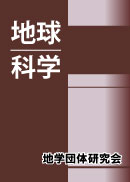All issues

Volume 63 (2009)
- Issue 6 Pages 343-
- Issue 5 Pages 267-
- Issue 4 Pages 193-
- Issue 3 Pages 115-
- Issue 2 Pages 61-
- Issue 1 Pages 1-
Volume 63, Issue 6
Displaying 1-6 of 6 articles from this issue
- |<
- <
- 1
- >
- >|
-
Naomi USHIYAMA, Hisashi TANIYAMA, Fumio TSUNODAArticle type: Article
2009Volume 63Issue 6 Pages 343-354
Published: November 25, 2009
Released on J-STAGE: May 16, 2017
JOURNAL FREE ACCESSGround motion over a loosely coupled swaying faultblock is shown through three-dimensional non-lineardynamic simulations to be strengthened near the peripheral bounding faults. The model is considered the Rokko fault block in West Japan, which has been identified as such a swaying fault block. One of the peripheral faults bounding this block was activated during the 1995 South Hyogo Prefecture Earthquake (M7.3) in Kobe, and high seismicity along the fault appears to have impeded complete cohesion among the blocks in the area. The Rokko fault block rose as a horst structure in the late Pliocene to middle Pleistocene, and is bounded by a steep inward-dipping fracture. Crushed zones associated with other peripheral active faults of the Rokko massif have similar depth and high seismicity, confirming the Rokko block to be a swaying fault block. The strong peripheral ground motion simulated by assuming a vibrating cube adhered loosely to the host rock is in accordance with the prediction of seimic risk for the plain, where fault blocks are similarly embedded with loose adhesion.View full abstractDownload PDF (1935K) -
Shigeki CHIBAArticle type: Article
2009Volume 63Issue 6 Pages 355-364
Published: November 25, 2009
Released on J-STAGE: May 16, 2017
JOURNAL FREE ACCESSBandai volcano consists of three peaks of the Bandaisan, Kushigamine and Akahaniyama. On July 15^<th> 1888, a phreatic eruption occurred on the north side of the Bandai volcano. After this eruption, Kobandaisan collapsed. The debris flow went down mostly in the north-eastward direction, however some traveled down on the south-eastward side. In 1985, Chiba discovered concave geographical features in the Kagami-numa, the top of the Bandai volcano. Chiba did field investigations, and created a map detailing position, and created a cross section. From the following points, I reached the conclusion that the concave geographical features of Kagami-numa were impact craters which formed by an eruption of 1888. (1) Some theses at 1888 eruption of Bandai volcano discuss the cinder falls and the resultant impact craters. (2) A perpendicular section of these concave geographical features of the Kagami-numa has the shape of a reverse cone and opens in the direction of the explosion in 1888. (3) The features of the sand boil isn't seen in these concave geographical features in the Kagami-numa. (4) The previous eruption occurred 1200 years before the one in 1888. It is very unlikely that the impact craters of an eruption that occurred 1200 years before still exist. (5) Stones are distributed over the marsh bottom, but stones are not found in these concave geographical features, suggesting that these concave geographical features are new. The impact craters from the eruption of 1888 also exists on Numanotaira and Akahani-yama.View full abstractDownload PDF (3420K) -
Takayuki MatsumotoArticle type: Article
2009Volume 63Issue 6 Pages 365-369
Published: November 25, 2009
Released on J-STAGE: May 16, 2017
JOURNAL FREE ACCESSThe fossil spores and pollen were newly collected from the Lower Cretaceous Arida Formation of the Chichibu Composite Belt in western Kii Peninsula, southwestern Japan. The obtained fossils are Taxodiaceaepollenites spp., Cicatricosisporites cf. australiensis, Cicatricosisporites sp., Cicatricosisporites? sp., Baltisphaeridium, etc. These fossils indicate Cretaceous age. This age doesn't contradict the current views of Barremian age for the Arida Formation.View full abstractDownload PDF (1356K) -
Yuji OKIMURA, Teruko ASAMI, Akinori HOSONOArticle type: Article
2009Volume 63Issue 6 Pages 371-375
Published: November 25, 2009
Released on J-STAGE: May 16, 2017
JOURNAL FREE ACCESSMany isolated micro-fossils consisting of various biota have been obtained from the unconsolidated fissure filling sediments developed in the Upper and Uppermost Formations of the Permian Akasaka Limestone, Gifu Prefecture, Central Japan. The tests of all the specimens sustain some influences of mechanical and chemical actions. Therefore the detailed paleontological description of the Smaller foraminifera is impossible. However, the identification at generic level is possible based on the chamberform and arrangement conjectured from the scanning electoronic micrographs of the inner casts. They are variostomatids, Climaccammina spp., Cribrogenerina spp., Nankinella sp., cf. Geinitzina sp.,and cf. Astacolus sp. It is noteworthy that the last two species and some variostomatid specimens can not be compared with any Permian species, but have characteristics very similar to those reported from the Lower Triassic in China.View full abstractDownload PDF (1962K) -
Kiichi OBATAArticle type: Article
2009Volume 63Issue 6 Pages 377-382
Published: November 25, 2009
Released on J-STAGE: May 16, 2017
JOURNAL FREE ACCESSDownload PDF (2662K) -
Yasumoto SUZUKIArticle type: Article
2009Volume 63Issue 6 Pages 383-387
Published: November 25, 2009
Released on J-STAGE: May 16, 2017
JOURNAL FREE ACCESSDownload PDF (1035K)
- |<
- <
- 1
- >
- >|